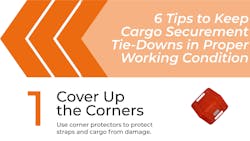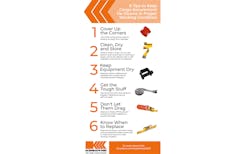When it comes to cargo securement, having the proper type and quantity of tie-downs is only half the battle.
In order to safely secure a load, tie-downs must be in good working condition without cuts, burns, holes or other evidence of damage. It’s important to closely examine cargo control equipment before securing every load to ensure that it is safe to use and that it meets all federal, provincial, state and local requirements in the United States and Canada.
“While it’s easy for drivers who are in a hurry to consider skipping the step of examining their tie-downs before securing every load, it’s a vital step in safely securing their cargo,” says Bob Dissinger, Kinedyne’s director of US sales. “Keeping tie-downs in good condition doesn’t have to be difficult—there are simple things that can be done to make sure it’s safe to use them. Assuming that the tie-downs are OK to use because they were fine during the previous load could be a costly mistake.”
Even the highest-quality cargo securement equipment will become less effective over time due to regular wear and tear, exposure to harsh weather, and stress from securing heavy loads, Kinedyne said. So the cargo control company is offering these 6 Tips to Keep Cargo Securement Tie-Downs in Proper Working Condition:
- Cover up the corners: When hauling cargo with sharp edges, use corner protectors to protect straps. Equipment like cargo corner and edge protectors are designed to snuggly fit along the corners of the cargo, acting as a protecting buffer for the straps, cables, and chains to lie on instead of the sharp edge. If the load lacks a 90-degree edge, use protective sleeves to protect against abrasive materials.
- Clean, dry and store: Straps are going to get dirty. But for them to work properly, they can’t stay that way. The Web Sling & Tie Down Association standards prohibit washing slings and tie downs as it can cause loss of strength or chemical damage. WSTDA states that rinsing or soaking with water and a mild detergent is acceptable. Do not use bleach, harsh chemicals, or brushing. Let the straps air dry before storing them out of sunlight. If straps cannot be cleaned with rinsing, they should be replaced.
- Keep equipment dry: Keeping chains, webbing and hardware dry is important to maintaining their integrity. Exposing hardware to moisture for too long can eventually degrade the quality of the material. If the equipment is constantly exposed to water, consider switching to stainless-steel hardware.
- Get the tough stuff: When hauling heavy or rough loads like concrete, bricks, wood or other construction materials, use tie-downs designed to withstand the additional strain. Select straps made with extra abrasion-resistant webbing to secure these loads.
- Don’t let them drag: Keep your straps off the ground. The abuse from being constantly whipped around or getting caught under the wheels weakens the straps. You could use duct tape, rubber bands, bungee cords, or specially designed storage devices such as the StrapPak to secure excessive webbing and prevent damage.
- Know when to replace: Even the best equipment won’t last forever. Examine tie-downs before securing every load to make sure they are in safe working condition. At the first sign of damage, take the tie-down out of service. Replacing tie-downs that are damaged will protect the cargo, driver and general public.
Visit kinedyne.com/roadcheck2020 for more information.

